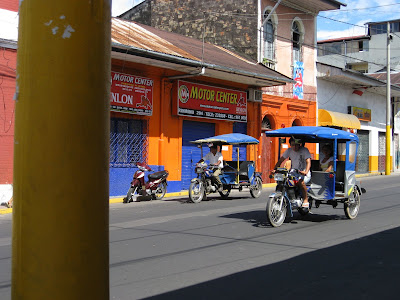 Be sure to ride the moto-taxis in Iquitos, and hold on tight
Be sure to ride the moto-taxis in Iquitos, and hold on tightIf you're interested in adventure travel, as in someplace really different from home and not too expensive, consider Peru. If you want a ground-level view of what's really going down in the tropical world, Peru will show you that.
We're just back from 24 days in Peru, a trip that included the Amazon, the Andes, and the desert along the Pacific Coast. Peru is one of the most varied and stunning countries I've seen. It has the highest biodiversity of any country on the planet - a big bonus for us. We also found opportunities to interact with indigenous people in villages along the Amazon and in the Andes. One of our goals was to spend as much time as possible in places where other Americans don't go - remote villages and nature reserves. We accomplished that, partly by avoiding Machu Picchu and the Sacred Valley.
My trip included husband Ken, son Alan, and daughter Sadie. Sadie and Alan are both in their twenties.
A whole lotta birds We saw 301 species of birds in Peru - not bad. Compared to 314 species in Costa Rica (over a period of 12 weeks), 220 in Kenya, and 141 in South Africa. [The Kenya trip was only Alan.] Birds we saw in Peru included the Humboldt penguin, Inca tern, Peruvian booby, Peruvian pelican, blue and yellow macaw, vermillion flycatcher, white-throated toucan, wattled jacana, Andean flicker, white-winged parakeet, burrowing owl, etc. I can post a list if anyone is interested. Leave a comment on the blog and tell me.
 A street vendor in Iquitos
A street vendor in Iquitos
Wild and woolly IquitosWe spent 4 or 5 days in Iquitos, the world's largest city that's not accessible by road but only by river or air. It's a friendly, hyper, and funky little town on the Amazon River. And cheap. Our lodging cost us $9 per person per day, on a quiet dead-end street that ends at the river. The roads of Iquitos are traversed by "moto-taxis" instead of cars, like 3-wheeled motorcycles with go-cart engines (see picture at top of post). For half a dollar, a mototaxi will take you anywhere, darting through town at break-neck speed. A first-class thrill, better than any carnival ride. I love Iquitos. I would move there next week if I had a job there and I'm not kidding.
Biological station on stiltsAfter a few days in charming Iquitos, we took a boat to a very remote biological station about 90 river-miles from Iquitos. We went east on the Amazon and south on its tributary, the Orosa River. The biological station,
Madre Selva, is operated by
Project Amazonas, a conservation and humanitarian non-profit. The station provides "rustic" lodging for biologists studying Amazonian plants and animals. Project Amazonas also offers some medical aid to remote families and under-served villages on the rivers. At the biological station, we slept in tents on raised wooden platforms under a thatched roof. Thatched homes with open sides are traditional in Amazonia. Every single house you pass on the river is built that way, and on stilts, which protect against flooding - because Peru has a rainy season and a dry season and water levels fluctuate dramatically. Summer in the U.S. is Peru's dry season, good for travel. Especially July and August.
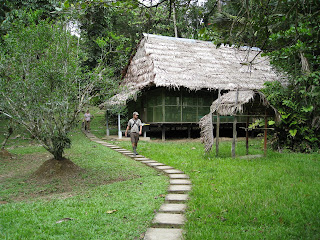

Photos: Our housing at Madre Selva, outside and inside. Our house had screen walls, but most homes don't.
We had the station to ourselves, with our Peruvian helpersThe biological station is open to anyone who wants to go. The director of Project Amazonas, Dr. Devon Graham, is affiliated with Florida International University (in Miami) and frequently takes student groups to the station to study the use of forest resources by local people, all of whom are indigenous. He also takes groups of tourists, but none were there when we were. We had the station all to ourselves, along with our cook, boatman, and our naturalist guide - all native Peruvians whom Devon engaged for us.
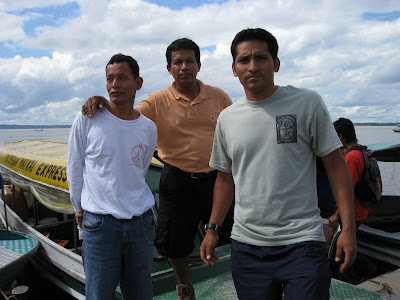 Photo: Our boat is visible behind Raul Viena our cook, Edwin Ruiz our boatman, and Cesar Peña our naturalist guide
Photo: Our boat is visible behind Raul Viena our cook, Edwin Ruiz our boatman, and Cesar Peña our naturalist guide
We
loved the local indigenous children who paddled over to the station every day in their dugout canoes. When their mothers came too, they brought stuff to trade: woven baskets, bags, fans, carved jewelry. The moms welcomed what we offered: lotion, mosquito netting, toothpaste, socks, shirts, anything. Sometimes the children brought their "pets" to show us: lizards, turtles, and even monkeys! This was not at our request, and we were uncomfortable seeing wildlife as pets, especially the primates. But as we learned, people living in remote places along the Amazon do keep wildlife as pets. We saw plenty of wildlife for sale as meat too, back in Iquitos, which made us equally uncomfortable.
But we were grateful to have the chance to talk with the families around the biological station.
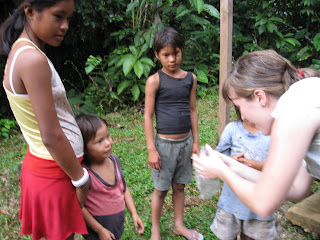
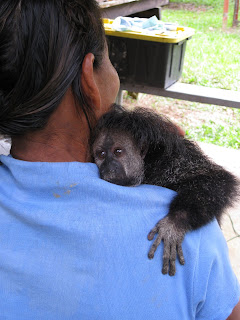
Above photo: A group of sisters brought us a little frog in a baggie (which Sadie released into the forest). Right: Another family brought their two pet monkeys to visit with us, just to be neighborly. The monkey pictured is a monk saki monkey.
Belen market: teeming with life and deathCaptive wildlife often winds up in Iquitos. Part of Iquitos is a floating shantytown of huts built on rafts that rise and fall with the river. The floating area of the city, called Belen, has an extensive and colorful open-air market on the shore, which offers every imaginable jungle resource. It's an exotic sensory deluge, crammed with foods and spices and jungle products I've never seen before. It reminded me of Diagon Alley in the Harry Potter books for some reason, maybe because of all the traditional medicines for sale, made of plant and animal parts. (The use of animal parts to treat ailments and impotence worldwide is based almost entirely on superstition, folklore and tradition. I don't know of any animal parts that have been demonstrated to be effective medicine.) The part of the Belen market that offered traditional medicines was troubling, and fascinating.
As I've written elsewhere, the trade in wildlife and wildlife parts worldwide is the third most lucrative blackmarket commodity in the world, after drugs and arms (according to Interpol).
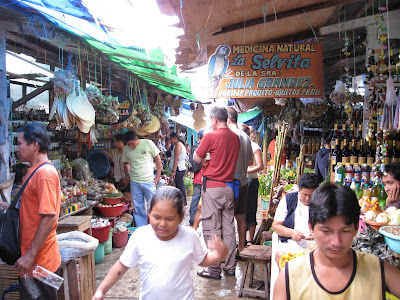 Photo above: In the Belen market, plant and animal parts were sold as medicine (see "Medicina Natural" sign above. "La Selvita" means "The Little Jungle.")
Photo above: In the Belen market, plant and animal parts were sold as medicine (see "Medicina Natural" sign above. "La Selvita" means "The Little Jungle.")I saw traditional medicines made of animal parts while visiting a medicine man in
a remote village in South Africa last year. He had a few animal tails and skulls, and some unidentified animal parts in jars, but his collection of animal parts was meager compared to the array on display in the Belen market.
We also saw baby monkeys for sale in the Belen market, for 5 soles, about $2 each. I was stunned at that. These were saddle-backed tamarins, spider monkeys, pygmy marmosets, animals whose habitats and population numbers are declining, and who should be protected. There were more than monkeys for sale....living anteaters, parrots, and sloths, too. It was distressing, yes, but if it's happening, I want to know about it. I was grateful for the opportunity to see it for myself, and grateful to our guide Cesar Pena for taking me there. Cesar has been a nature guide on the Amazon for Project Amazonas for 12 years. He works independently too. If you're interested in hiring him as a guide on the Peruvian Amazon, contact him directly at cesars99@hotmail.com. His phone number in Iquitos is 965-658361. To call him from the U.S., dial 011.51.65.965658361.
Rosa was a life-saver in planning our trip. Maybe literally. Before this post gets too long, I want to recommend an excellent resource for anyone considering a trip to Peru. Rosa Vasquez Zanetti. Her family owns and operates the modest little inn where we stayed in Iquitos, the
Hospedaje La Pascana. Rosa is also an excellent travel agent, through her own
Pascana Amazon Services. Not only did she make a number of our bookings before we arrived in Peru, she also helped me change some of our Andes plans at the last minute while we were in Iquitos. She recommended some safer means of bus travel into the mountains for us, and booked the tickets. She also recommended safer and more interesting mountain towns and Andean peaks for our hiking plans, and she booked those too, while we were in Iquitos. She was a fantastic resource and speaks very good English. You can contact Rosa directly at reservas@pascana.com or call her in Iquitos. From the U.S., her number is 011.51.65.233466
. I'll write another post about what we did in the Andes.
I recommend Miguel QuevedoI want to recommend too a Peruvian driver that we hired to drive us from Lima to the Reservas de Paracas, a mind-blowing desert nature reserve 4 hours south of Lima. Devon Graham of Project Amazonas recommended both Miguel and Rosa to us. Miguel stayed with us the entire 56 hours or so (two nights) that we spent in the area of Paracas. When we left the car to go birding, he stayed with the car to guard our things. His name is Miguel Quevedo. He's smart, responsible, trustworthy, fun. On many occasions, he acted as our advocate - straightening out misunderstandings with vendors, etc. Miguel can be reached through Rosa Vasquez Zanetti (she will call him for you if you email her at reservas@pascana.com.) Or you can call him directly, but he speaks little English. His phone number in Lima is (511) 99664-1254. If calling from the U.S., it's
011 511 996641254.  Miguel and Sadie at supper, at Paracas on the Pacific coast
Miguel and Sadie at supper, at Paracas on the Pacific coastMore later on Peru, and why I long to get back there.
Photos and text by Sally Kneidel
Keywords::Peru travel, adventure travel, Amazon, Andes, Paracas, Iquitos, South America, tropics









